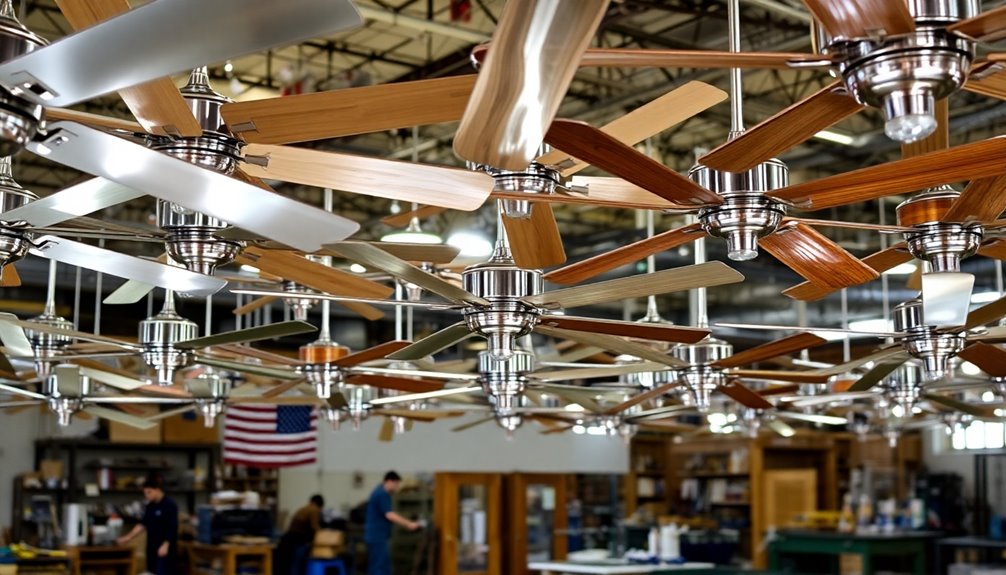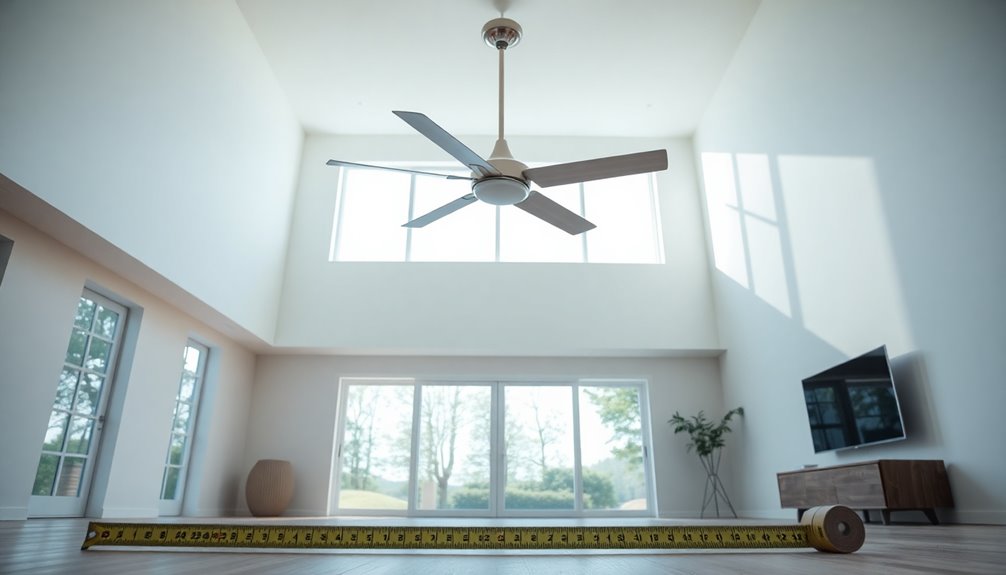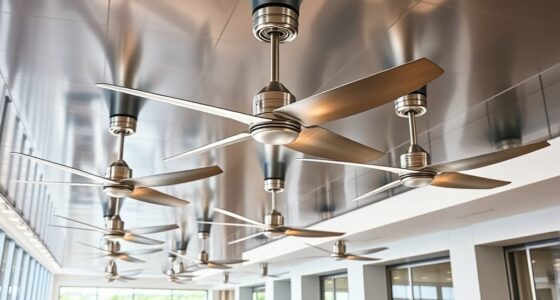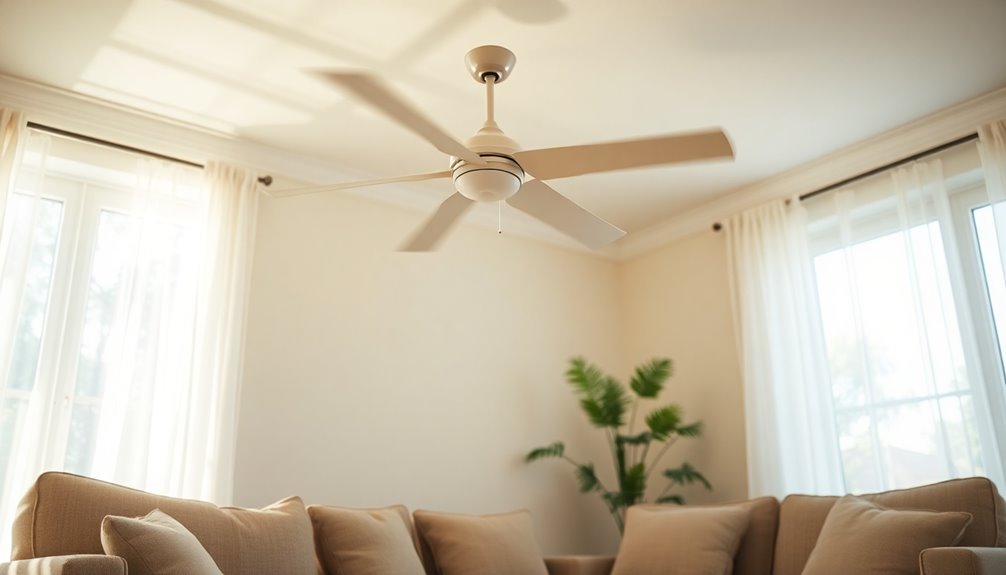Running a ceiling fan typically costs you between $2 to $5 a month. This varies based on how often you use it and its energy efficiency. For example, operating a 75-watt fan for eight hours daily could rack up about $4.14 monthly. Larger fans and higher speed settings can increase your expenses too. If you invest in an ENERGY STAR-rated fan, you might save 20-30% on electricity. To keep costs down, consider using fans only when rooms are occupied. There are plenty of tips out there for more savings that you might find interesting.
Key Takeaways
- Running a ceiling fan typically costs between $2 and $5 monthly, depending on usage and fan size.
- Operating a 75-watt fan for 8 hours daily costs around $4.14 monthly.
- ENERGY STAR-rated fans can reduce energy consumption by 20-30% compared to standard models.
- Regular maintenance can enhance fan efficiency and lower operating costs by 20-30%.
- Operating fans only when rooms are occupied can further save on energy expenses.
Cost Breakdown of Ceiling Fans

When you consider how much it costs to run a ceiling fan, you'll find it surprisingly economical. The average monthly expense for a ceiling fan ranges from just $2 to $5, depending on usage and energy consumption.
If you operate a 75-watt ceiling fan for about 8 hours daily, you'll spend roughly $4.14 a month—far less than central air conditioning, which can run you $3.36 to $8.40 daily.
The energy consumption of ceiling fans typically falls between 30 to 100 watts, so larger models might consume a bit more electricity. However, even at the higher end, your running costs remain manageable.
Over a year, you can expect to spend between $25 to $65 on electricity for your ceiling fan, making it a budget-friendly option for cooling your home. Additionally, regular maintenance can prevent dangerous situations that may arise from mechanical failures, ensuring your fan operates efficiently.
While you'll need to account for installation costs, the overall savings on your electricity bill can still help you save money in the long run.
Factors Affecting Running Costs

When you're considering the running costs of a ceiling fan, size and energy efficiency ratings are key factors to keep in mind.
The longer you run the fan, the more it'll impact your electricity bill, especially if you choose higher speed settings. Understanding these elements can help you make smarter decisions about your fan usage and costs. Additionally, energy-efficient technology can significantly reduce overall electricity consumption, leading to further savings on your bill.
Fan Size Impact
The size of your ceiling fan plays an important role in determining its running costs. Smaller fans, like those with a 36-inch diameter, typically use around 55 watts, while medium fans at 48 inches consume about 75 watts. If you opt for a larger 52-inch fan, you'll be looking at approximately 90 watts.
Keep in mind that some large fans can consume up to 180 watts, which can greatly increase your operational costs, especially if you run them for extended periods.
When you consider the average cost of running a medium-sized ceiling fan for 8 hours daily, you're looking at around $2.88 per month. In contrast, larger fans can drive this cost much higher.
To help manage your electricity cost, consider selecting ENERGY STAR-rated fans, which can use 20-30% less power than conventional models, ultimately reducing your running costs.
Additionally, the speed settings you choose affect energy consumption. Higher speeds will increase electricity usage, so it's crucial to choose the appropriate settings based on your cooling needs.
If you're unsure about your fan's efficiency, an energy audit can provide valuable insights.
Energy Efficiency Ratings
Energy efficiency ratings play an essential role in determining how much it costs to run your ceiling fan. Fans with ENERGY STAR ratings can be up to 60% more energy-efficient than standard models, which considerably lowers your running costs.
The wattage of your ceiling fan impacts its energy usage, with typical ranges from 30 to 100 watts. Larger fans usually consume more energy, raising operating costs. Additionally, the fan speed setting you choose affects energy consumption; higher speeds lead to increased electricity use, which can add up over time. Regular maintenance, like cleaning the blades, can also enhance efficiency, further affecting energy consumption.
Here's a quick comparison of ceiling fan options based on their ratings and costs:
| Fan Type | Wattage (Watts) | Monthly Operating Cost ($) |
|---|---|---|
| ENERGY STAR | 30-50 | 2-3 |
| Standard Model | 50-70 | 3-4 |
| High Wattage Fan | 80-100 | 4-5 |
| Low Wattage Fan | 20-30 | 1-2 |
Usage Duration Effects
Usage duration has a significant impact on your ceiling fan's running costs. If you run your ceiling fan continuously for 24 hours, you could spend between $0.24 and $0.48. This small amount adds up quickly when you consider it over a month.
For example, running a ceiling fan for just 8 hours a day can lead to monthly costs of around $2.50 to $5.00, depending on your local electricity rate and the fan's wattage.
The speed setting also plays a role in electricity usage; higher speeds consume more power and can increase your overall costs. To help save energy, it's wise to turn off the ceiling fan when you leave a room. Every hour that the fan isn't running directly reduces your monthly costs, making a noticeable difference over time.
Additionally, keep in mind the fan installation costs when budgeting. While the initial investment may seem significant, understanding how usage duration affects your expenses can help you manage running a ceiling fan more efficiently.
Energy Consumption Comparison

When comparing cooling options for your home, ceiling fans offer a budget-friendly alternative to more energy-hungry systems like air conditioning. Ceiling fans typically consume between 30 to 100 watts per hour to run, translating to an average cost of just $0.01 to $0.02 per hour. In contrast, an air conditioning system can consume around 3,500 watts, leading to daily costs of $3.36 to $8.40.
Here's a quick comparison of the costs:
| Cooling Option | Cost per Hour |
|---|---|
| Ceiling Fan | $0.01 – $0.02 |
| Air Conditioning | $0.14 – $1.20 |
| Ceiling Fan (8 hrs) | $0.14 |
| AC (8 hrs) | $1.20 |
| Ceiling Fan (Month) | $2 – $5 |
Operating a ceiling fan for a month costs around $2 to $5, while air conditioning can rack up $87 to $175 in cooling costs. Opting for energy-efficient ceiling fans can save you up to 60% in energy consumption, making them a smart choice for lowering your electricity bills.
Cost-Reduction Strategies

To save money on your ceiling fan costs, start by optimizing when you use it; only run the fan in occupied rooms. Investing in ENERGY STAR-rated models can also make a big difference in your energy consumption. Additionally, consider using best airflow ceiling fans to maximize efficiency while keeping your space comfortable. Moreover, utilizing energy-efficient appliances helps reduce overall household energy costs. Regular maintenance of your ceiling fan, such as cleaning fan blades, can further enhance its efficiency and performance. With these strategies, you can enjoy a cooler home without breaking the bank. Furthermore, ensuring good indoor air quality can complement the cooling effects of your ceiling fan, making your living space more comfortable.
Optimize Usage Timing
Optimizing the timing of your ceiling fan usage can greatly reduce your energy costs. To maximize energy savings, operate your ceiling fan only when rooms are occupied. Running it continuously can add $2 to $5 to your monthly running costs, so it's best to be mindful of when it's on.
Consider using smart controls or timers to automate this process, ensuring the fan turns off after a set period.
Regular maintenance is essential for peak performance. Clean the fan blades to improve air circulation and efficiency, which can lead to lower electricity usage.
Also, adjust the fan speed according to the room's temperature; using lower speeds can considerably cut down on running costs.
You can further maximize energy savings by combining ceiling fan use with open windows. This allows for natural ventilation, enabling you to set your thermostat higher without sacrificing comfort. Additionally, incorporating energy-efficient models can significantly enhance your overall energy savings while using ceiling fans in conjunction with heating and cooling systems.
Invest in Efficiency
Investing in efficiency is key to reducing your ceiling fan operating costs. By operating your ceiling fan only when rooms are occupied, you can greatly save energy and lower your bills. With fans consuming just $0.01 to $0.02 per hour, it's easy to see how smart usage can make a difference.
Consider utilizing timers or smart controls to limit how long you run the fan; this can cut your monthly energy expenses, which typically range from $2 to $5 for standard use.
Regular maintenance, like cleaning fan blades, also improves efficiency and helps you avoid the upper end of estimated annual costs, which can reach $65 for continuous operation.
If you're thinking about a new installation, opting for ENERGY STAR-rated ceiling fans can save you up to 60% in energy usage compared to conventional models.
Additionally, adjusting fan speed settings to lower levels can conserve energy since higher speeds usually lead to increased electricity consumption.
Energy-Saving Tips

Maximizing your ceiling fan's efficiency can lead to significant savings on your energy bill. By implementing a few energy-saving tips, you can reduce costs while enjoying a comfortable environment.
Here's how to get the most out of your ceiling fan:
- Use your fan only when rooms are occupied. They cost around $0.01 to $0.02 per hour to run, so turn them off when you leave.
- Opt for lower speed settings. Higher speeds increase energy consumption, affecting your monthly electricity bill more than you might realize.
- Perform regular maintenance. Cleaning the blades can enhance fan efficiency, potentially saving you 20-30% on energy use compared to neglected fans.
- Adjust your thermostat. Setting it 4°F higher when using your ceiling fan can boost comfort while reducing the workload on your air conditioning system.
Consider investing in ENERGY STAR-rated ceiling fans, as they can save you up to 60% on energy usage compared to conventional models.
Installation and Service Costs

While you've taken steps to enhance your ceiling fan's energy efficiency, the installation and service costs are also important to take into account.
If you're considering ceiling fan installation, the cost typically ranges from $100 to $300 for professional installation. This price varies based on the complexity and location of the installation.
If you're handy and have the right tools, a DIY installation could save you on labor costs. However, for complex installations, it's best to consult licensed electricians to guarantee safety and efficiency.
Regular maintenance services are essential for keeping your ceiling fan operating at peak performance. These services can improve energy efficiency, but service costs can vary widely based on local rates.
Investing in high-quality installation services not only enhances the longevity of your ceiling fan but also boosts its functionality, leading to better overall cost efficiency in the long run.
Remember, a well-installed ceiling fan can save you money on energy bills, making the initial investment worthwhile.
Frequently Asked Questions
How Much Does It Cost to Run a Ceiling Fan 24 Hours a Day?
When you run a ceiling fan for 24 hours, you're looking at a cost between $0.24 and $0.48. This depends on the wattage of your fan and local electricity rates.
On average, most ceiling fans use about 0.6 to 0.9 kWh daily, meaning your monthly bill could range from $2 to $5.
Compared to air conditioning, that's a pretty economical choice for keeping your space comfortable!
Does Running a Ceiling Fan Use a Lot of Electricity?
Running a ceiling fan doesn't use a lot of electricity; it's actually quite efficient.
Compared to air conditioning units, which can drain your energy, ceiling fans typically consume only 30 to 100 watts per hour.
You'll find that even at maximum speed, they still use far less energy.
By choosing an ENERGY STAR-rated model, you'll save even more, enjoying comfort without worrying about high electricity bills.
It's a smart choice for any home!
Do Ceiling Fans Raise Electric Bill?
Ceiling fans generally don't raise your electric bill considerably.
When you run one, it costs just a few dollars a month, depending on how often you use it. In fact, the energy consumption is quite low, averaging around $0.01 to $0.02 per hour.
If you keep your fan well-maintained and choose energy-efficient models, you can enjoy a comfortable environment without worrying about a hefty increase in your electricity costs.
How Much Does It Cost to Run a Floor Fan 24 Hours a Day?
When you run a small floor fan for 24 hours, it'll cost you about $1.09 a month, consuming around 28.5 watts.
A medium fan bumps that to roughly $2.02 monthly at 52.7 watts, while a large fan still keeps it affordable at about $1.70 for 44.3 watts.
Compared to air conditioning, floor fans are a cost-effective way to stay cool without breaking the bank.
You'll save money while enjoying comfortable airflow!
Conclusion
To sum up, running a ceiling fan is surprisingly affordable, typically costing you just about $0.01 to $0.02 per hour. That's a small price to pay for comfort! Plus, with energy-efficient models, you could save even more. As a bonus, using a ceiling fan can help lower your air conditioning costs by up to 30%. So, next time you need a breeze, remember that a ceiling fan is not just a cool choice but a budget-friendly one too!









